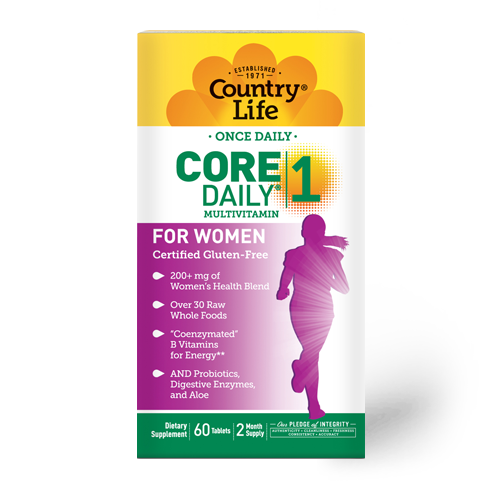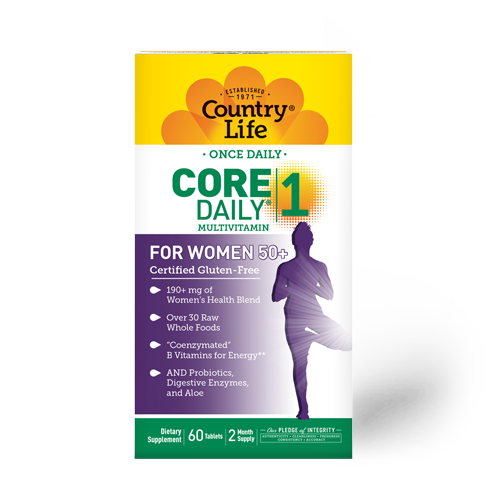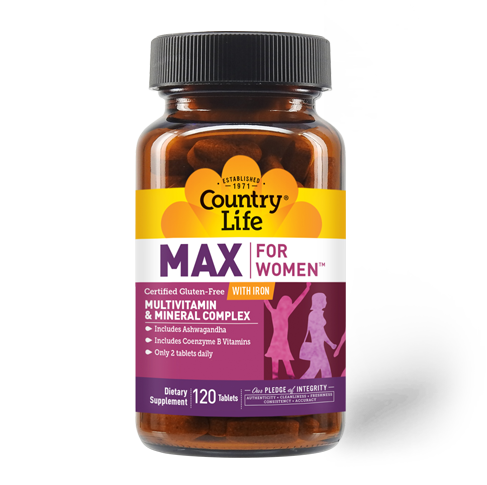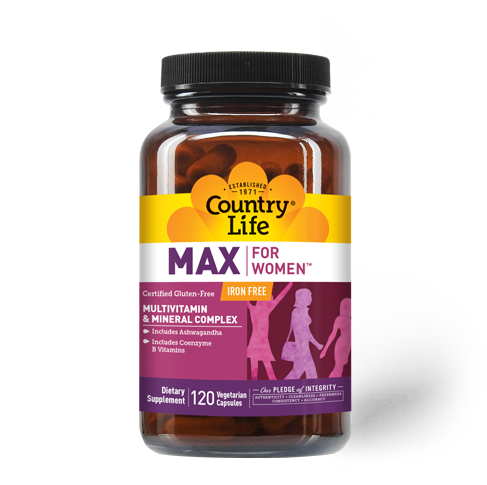It’s no secret that women have unique nutritional needs, such as greater demands for iron, vitamin D, and B vitamins.
These needs may also change based on age, genetics, stress level, eating habits, state of health, hormonal changes, and season of life.
Although eating a healthy and diverse whole foods diet is the best way to get your vitamins, many doctors, dieticians, and nutrition experts recommend multivitamins to help optimize nutrition and fill in any nutrient gaps.
Yet, many women still rely on generic multivitamins, which often lack the most bioavailable forms, concentrations, and amounts of nutrients to meet their needs.
So, how do you choose the best multivitamin for women?
In this article, you’ll learn five simple steps to help you vet the best women’s multivitamin supplements, plus FAQs and resources for high-quality women’s multis.
What’s the Difference Between Women’s Multivitamins and Regular Multivitamins?
The difference between women’s multivitamins and regular multivitamins or men’s multivitamins depends on the brand and formulation.
Although supplement companies must operate under Current Good Manufacturing Practices (cGMP) as dictated and monitored by the FDA, the FDA does not regulate multivitamin formulas.
Therefore, these can vary significantly in their ingredients, concentration, and quality.
Regardless, a multivitamin should be designed with various essential vitamins to help the consumer meet or exceed the recommended daily allowances (RDA).
Some multivitamins also contain minerals, herbs, antioxidants, essential fatty acids, and other superfoods, while others just stick to essential vitamins like A, B, C, D, and iron.
Women’s multivitamins are generally tailored to meet the unique nutritional and health needs of women at different stages of life, which differ from men. For this reason, they are often a blend of essential vitamins, minerals, and superfoods.
For example, most women’s multivitamins contain iron, while most men’s multivitamins do not.
Women’s multivitamins may also contain higher amounts of B vitamins, including folate and vitamin B12, which are especially important during childbearing.
Some brands of women’s multivitamins also include female support herbs like red raspberry, nettles, or cranberry and/or ingredients or superfoods to promote healthy aging, such as resveratrol, green tea, or bioflavonoids.
Higher-quality brands may also include female-specific probiotics, methylated B vitamins, digestive enzymes, amino acids, and other super fruits, vegetables, algae, etc.
The main benefit of choosing a women’s multivitamin versus a standard multivitamin is that with proper vetting, you’ll get more bang for your buck with higher concentrations of the most bioavailable nutrients specific to women.
However, not every brand of women’s multivitamin is created equal.
Next, we’ll share a simple vetting process to help you avoid inferior multivitamins and make the best investment in a high-quality women’s multivitamin supplement.
5 Steps To Vetting The Best Women’s Multivitamin For You
Just a few years ago, choosing a women’s multivitamin was simple because only a few were available.
Fast-forward to today, and between hundreds of brands, conflicting ratings, varying expert opinions, and social media trends, picking the best women’s multivitamin has gotten downright confusing.
Fortunately, there is a simple vetting process you can follow to cut through the noise and ensure you’re getting exactly what you need from your women’s multi.
Step 1: Consider Having Your Nutrient Levels Tested
Taking a high-quality multivitamin is an excellent way to ensure you’re meeting your daily nutrient requirements.
However, the only way to know for sure which nutrients you need more of is to test.
Although nutrient tests are limited, they can give you a good baseline of what you may be lacking, such as B12, iron, and vitamin D.
This can be extremely helpful when choosing a multivitamin.
While you’re at it, you may also consider getting checked for any genetic variations that may impact your ability to metabolize certain nutrients, like B vitamins.
If you find you have a genetic variation, like MTHFR, choosing a multivitamin with methylated B-vitamins, like methylcobalamin and methylfolate, will ensure your body can absorb those essential nutrients.
The bottom line is it is generally safe to take a multivitamin without having your nutrient levels checked so long as nutrient levels do not exceed RDAs.
However, testing can help you target your search for multivitamins containing optimal levels and forms of certain nutrients.
Step 2: Look For These Key Nutrients In Your Women’s Multi
A high-quality women’s multivitamin should contain a balanced blend of the essential vitamins and minerals you need to meet your daily requirements, including:
- Vitamin A (beta carotene): Vital for proper immune function, cell, eye, skin, heart, lung, and brain health
- Vitamin C: Promotes healthy immune function, collagen production, metabolic function, cellular health, gut health, and iron absorption. Ascorbic acid or calcium ascorbate forms are common, but some multis contain gentle food-based forms of vitamin C, such as acerola cherry and amla.
- Vitamin D: Essential for immune function, hormonal health, bone density, gut health, metabolic function, calcium absorption, nervous system function, muscular health, and more. Ideally, Vitamin D3 cholecalciferol, which is more bioavailable than Vitamin D2.
- Vitamin E: This essential antioxidant promotes eye, skin, hormonal, brain, immune, and cellular health.
- Vitamin K: Promotes optimal transport and absorption of vitamin D and calcium. Essential for bone, skin, hair, blood clotting, and cardiovascular health.
- Vitamin B1 (Thiamin): Supports healthy metabolic function, energy metabolism, cell health, and nervous system function.
- Vitamin B2 (Riboflavin): Promotes healthy energy production, cellular function, growth, and development, the metabolism of fats, drugs, and steroids, and is essential for amino acid conversion and maintaining normal homocysteine levels in the blood
- Vitamin B3 (Niacin): Over 400 enzymes require niacin to catalyze reactions in the body! It is essential for energy production, central nervous system health, cognitive protection, and cardiovascular health.
- Vitamin B5 (Pantothenic Acid): Essential for metabolism, including breaking down fats, healthy hair, skin, and nails, gut health, and healthy cholesterol
- Vitamin B6 (Pyridoxine): Essential for energy, protein metabolism, homocysteine homeostasis, cognitive development, neurotransmitter function, immune function, glucose metabolism, the formation of hemoglobin, mood in women, eye health in women when combined with B12 and folic acid, heart health, and more
- Vitamin B9 (Folate): Folate is vital for energy, cellular function, DNA repair, cardiovascular function, amino acid conversion, blood health, and preventing neural tube defects in babies. Ideally, choose a methylated or coenzymated form of folate to optimize absorption, such as (6S)-5-Methyltetrahydrofolate-glucosamine salt
- Vitamin B12 (Cobalamin): Promotes energy, mental health, normal cellular function, muscular function, healthy blood, central nervous system function, DNA synthesis amino acid synthesis, growth and development, memory and overall cognitive function, and more. Ideally, choose a methylated or coenzymated form of B12 to ensure optimal absorption, such as methylcobalamin.
- Iron: This mineral is essential for energy, brain development and function, oxygen transport, muscle metabolism, growth, healthy connective tissue, hormone synthesis, and more. Iron deficiency is also common in women. Note: Not every woman needs additional iron, which can be harmful. If your iron levels are optimal, choose an iron-free women’s multi.
- Biotin: Supports energy, cellular health, neurological function, gene synthesis, healthy hair, skin, and nails
Other helpful nutrients in women’s multivitamin supplements may include:
- Choline
- Zinc
- Iodine
- Molybdenum
- Magnesium
- Calcium
- Manganese
- Copper
- Potassium
- Phosphorus
- Probiotics such as acidophilus, bifidobacterium, and lactobacillus strains
- Prebiotic fiber such as inulin, chicory, potato starch, etc.
- Digestive enzymes like amylase, protease, cellulase, lipase, etc.
- Antioxidants like resveratrol, quercetin, bioflavonoids, etc.
- Various superfoods, such as acerola cherry, cranberry, spirulina, fermented greens, seed sprouts, chlorella, spirulina, functional mushrooms, and fruit extracts, are also included
- Herbs for female support like nettles, red raspberry leaf, ginger, turmeric, and aloe
- Essential fatty acids
- Amino acids
Note: Some people may have reactions to too much of a specific vitamin or mineral, such as flushing, nausea, jitters, or other symptoms. Talk to your doctor about your vitamin needs, and make sure you track any reactions you may have after taking a multivitamin.
People often wonder if it’s better to choose a multivitamin with more ingredients or less.
The answer depends on your nutritional needs.
However, one benefit of taking several vitamins, minerals, antioxidants, etc., at once is to take advantage of the symbiotic relationship between various nutrients.
For example:
- Iron is best absorbed in the presence of vitamin C.
- Vitamin D is critical to calcium and phosphorus metabolism.
- Vitamin K is also helpful to vitamin D for calcium transport.
- Probiotics are essential for the synthesis and absorption of B vitamins.
- Vitamin A and zinc and vitamin E and selenium share a symbiotic relationship related to immune function and defenses.
Although supplements should never replace a healthy diet, taking a multivitamin, especially with food, could impart comparable benefits to eating a variety of whole, colorful, and nutritious foods rich in nutrients.
This is one of many benefits of taking a female-specific multivitamin.
Step 3: Pay Attention to the Delivery System
You can find the best, highest-quality, custom-tailored women’s multivitamin in the world.
However, if it’s in a chunky, hard-to-swallow delivery system that requires you to swallow six pills daily, you’re probably not going to take it!
Therefore, choose your delivery system wisely.
Most multivitamins are available in vegetarian capsules or tablets, which are easy to swallow with water or food.
For example, Country Life’s Core Daily-1® for Women Multivitamin and Core Daily-1® for Women 50+ Multivitamin uses a one-tablet-per-day delivery system, making it easy to take your vitamins and get on with your day.
Our RealFood Organics® Multivitamin For Women uses a two-tablet-per-day delivery system (exclusively food-based nutrients take up more space in a tablet) that you can take at one or two intervals daily.
You can also find multivitamin gummies, liquids, and powders.
Step 4: Consider Your Season Of Life
The best women’s multivitamin supplement for you may vary based on your season of life.
For example, some women’s multivitamins target women over 40 or 50, menstruating women, and pregnant and/or lactating women.
These targeted formulas may include specific concentrations of certain nutrients that provide particular benefits during these times.
Step 5: Choose The Cleanest Brand Possible And Avoid Problem Ingredients
If you’ve ever wondered why some multivitamins are more expensive than others, it typically comes down to quality.
For example, many generic brands of women’s multivitamins contain 100% synthetic cheap vitamins in hard-to-absorb or outdated forms without symbiotic ingredients.
Some examples include Vitamin D2 instead of D3, non-methylated/coenzymated B vitamins, folic acid instead of methylated folate, or essential fatty acids from cheap fish oil sources.
Cheap multivitamins may also contain artificial ingredients, dyes, and fillers, which defeat the purpose of investing in your health.
Gummies may also be problematic if they contain added sugar, artificial sweeteners, colors, dyes, irritating gums, or gelatin (if you’re vegan or vegetarian).
This doesn’t mean you have choose the most expensive women’s multivitamin.
However, do consider buying from supplement companies who:
- Source the highest-quality vitamins, minerals, and nutrients
- Rigorously test raw materials and end-products to ensure safety, potency, and that what’s on the labels is actually what’s in the supplement
- Test for contaminants such as heavy metals, mold, bacteria, etc.
- Use non-GMO ingredients
- Do not use artificial colors, flavors, or other ingredients
Country Life Women’s Multivitamins meet all these criteria, plus are Certified Gluten-Free and manufactured in a Certified Organic cGMP compliant facility.
We’re also a B-Corp, which means we take care of our people, suppliers, and the planet.
You can’t get cleaner than that!
The Best Women’s Multivitamin FAQs
Have more questions about choosing the best women’s multivitamin? Check out these frequently asked questions.
Q: Do I need to take additional supplements, like vitamin D or omega-3s, if I’m already taking a women’s multi?
Eating a healthy diet plus taking a multivitamin will often take care of all your nutritional needs.
However, some people may benefit from taking additional supplements, especially if there is a deficiency, insufficiency, pre-existing condition, chronic stress, or other circumstances or you have specific health and wellness goals.
For example, many doctors recommend taking additional vitamin D in the winter months, some women like taking extra biotin for their hair, skin, and nails, and athletes may require more of certain nutrients.
Also, not all multivitamins contain every type of nutrient like omega-3s, for example.
Check with your doctor or healthcare practitioner for individual recommendations.
Q: Should I be concerned about herbs in multivitamins for women? Can they be harmful?
Not all multivitamins contain herbs.
However, some female multivitamins may contain herbs traditionally used and studied for women’s health.
In some of Country Life’s multivitamins for women we use ginger, which is well-known to support digestive health, circulation, and immune function, and ashwagandha in our Max for Women™ line for stress and hormone support.
We also include various whole, fermented, or sprouted superfoods like greens, fruits, millet, and lentils for added nutritional benefits.
These herbs are generally safe and are not included in quantities large enough to cause toxicity.
If you’re concerned, check with your doctor or healthcare practitioner.
Q: Does every woman need a multivitamin?
No, every woman’s nutritional needs are unique.
The best way to ensure you’re getting optimal nutrition is to eat a healthy and diverse whole foods diet with plenty of colorful foods, lean proteins, whole grains, and healthy fats.
A multivitamin may be helpful to help you reach your nutritional goals and fill in any nutrient gaps.
Q: My urine is bright yellow when I take a multivitamin. Should I be concerned?
No. B-vitamins naturally create a yellowing of urine in some people.
This is harmless and will likely change as your body adapts to your new supplement routine.
Q: What’s the difference between women’s multivitamins for different ages?
Women’s multivitamins for different age groups are typically formulated for the needs of women in their menstruating years, during pregnancy, perimenopause, menopause, and post-menopause.
For example Country Life’s Core Daily-1® for Women 50+ Multivitamin includes higher levels of calcium and vitamin D to support bone strength, B vitamins, and antioxidants to help maintain energy levels and overall vitality, and various nutrients for heart health, hormonal balance, and stress.
It is not always necessary to choose a multi based on your age solely for meeting nutrient requirements, but it may provide added benefits.
If you’re pregnant, be sure to take a prenatal-specific multivitamin as recommended by your OBGYN, midwife, or birth team.
Q: Are whole food-based women’s multivitamins better than synthetic ones?
That’s a great one question, and one that’s hotly debated in the nutrition, medical, and integrative medicine spaces.
The debate comes from conflicting research showing whole foods nutrients may be better absorbed than synthetic, and that certain synthetic forms of vitamins may be better absorbed than whole foods varieties.
Who is right? It depends who you ask, but more research is needed.
The good news is there are whole-food, traditional synthetic, and hybrid varieties available. If you’re unsure, check with your healthcare practitioner.
Discovery Country Life’s Top-Rated Women’s Multivitamin Supplements
We hope this information helps you in your quest to find the best women’s multivitamin to help you thrive.
As you’re looking, be sure to consider Country Life’s multivitamins for women, including:
Get More Information About Women’s Health In:
Sources mentioned in this article:
- Multivitamin/mineral Supplements”. National Institutes for Health Office of Dietary Supplements.
- “Vitamin A Fact Sheet for Health Professionals”.NIH Office of Dietary Supplements.
- “Vitamin C Fact Sheet for Health Professionals”. NIH Office of Dietary Supplements.
- “Vitamin D Fact Sheet for Health Professionals”. NIH Office of Dietary Supplements.
- “Vitamin E Fact Sheet for Health Professionals”. NIH Office of Dietary Supplements.
- “Vitamin K Fact Sheet for Health Professionals”. NIH Office of Dietary Supplements.
- “Thiamin Fact Sheet for Health Professionals”. NIH Office of Dietary Supplements.
- “Riboflavin Fact Sheet for Health Professionals”. NIH Office of Dietary Supplements.
- “Niacin Fact Sheet for Health Professionals”. NIH Office of Dietary Supplements.
- “Niacin in the Central Nervous System: An Update of Biological Aspects and Clinical Applications”. International Journal of Molecular Sciences
- “Pantothenic Acid Sheet for Health Professionals”. NIH Office of Dietary Supplements.
- “Folic Acid, Vitamin B6, and Vitamin B12 in Combination and Age-related Macular Degeneration in a Randomized Trial of Women”. Archives of Internal Medicine
- “Vitamin B6 Fact Sheet for Health Professionals”. NIH Office of Dietary Supplements.
- “Higher vitamin B6 intake is associated with lower depression and anxiety risk in women but not in men: A large cross-sectional study”. Int J Vitam Nutr Res.
- “Folate Fact Sheet for Health Professionals”. NIH Office of Dietary Supplements.
- “Vitamin B12 Fact Sheet for Health Professionals”. NIH Office of Dietary Supplements.
- “Iron Fact Sheet for Health Professionals”. NIH Office of Dietary Supplements.
- “Biotin Fact Sheet for Health Professionals”. NIH Office of Dietary Supplements.
- "Interaction of vitamins and minerals”. Arch Latinoam Nutr.
- “B Vitamins and Their Roles in Gut Health”. Microorganisms
- “Health benefits of fruit and vegetables are from additive and synergistic combinations of phytochemicals.” The American Journal of Clinical Nutrition
- “Synthetic vs. “Natural” Vitamins”. Realities of Nutrition. Judi S. Morrill
















Share:
The Health Benefits of Taking a Daily Multivitamin
What are the Benefits of Taking Biotin Vitamins?